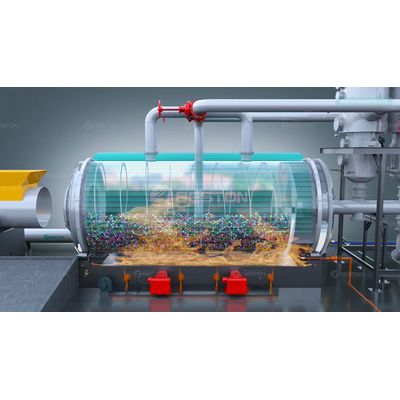


The Role of Thermal Efficiency in Pyrolysis Reactor Performance
The thermal efficiency of a pyrolysis reactor is a critical factor in determining the overall performance, energy consumption, and economic feasibility of the pyrolysis process. Pyrolysis, a thermochemical decomposition process, is used to convert organic materials such as plastics, rubber, and biomass into valuable products like oil, gas, and charcoal. The efficiency with which the reactor manages and utilizes heat can significantly impact the yield and quality of these byproducts, making it an essential consideration in the design and operation of pyrolysis systems.
Thermal Efficiency and Energy Consumption
At its core, pyrolysis involves heating feedstock to high temperatures (typically between 300°C and 900°C) in the absence of oxygen. The heat input is a driving factor for the breakdown of complex organic molecules into simpler compounds. However, if the reactor cannot effectively retain and utilize the heat, energy consumption increases, and operational costs rise. High thermal efficiency ensures that the reactor maintains optimal temperature levels throughout the process, reducing energy losses.
The design of the pyrolysis reactor plays a pivotal role in this aspect. Well-insulated reactors and advanced heat recovery systems help minimize energy waste. By efficiently recycling heat within the system, the reactor can operate with reduced external energy input, leading to significant cost savings in the long run. This makes thermal efficiency a key factor in improving the economic viability of pyrolysis projects, especially when dealing with high volumes of waste or low-value feedstocks.
Impact on Product Yield and Quality
Thermal efficiency also directly affects the yield and quality of the pyrolysis products. In a well-designed pyrolysis reactor, the heat is distributed evenly, ensuring that the feedstock is uniformly heated. This uniform heating prevents localized overheating, which could lead to the production of undesirable byproducts such as excessive char or gas. Instead, the controlled thermal environment enables the reactor to produce higher-quality liquid oils, gases, and charcoal, with better consistency.
For example, the oil produced from pyrolysis can vary in chemical composition depending on the temperature and rate at which the reactor is heated. Efficient thermal management allows for precise control of these parameters, resulting in a higher proportion of valuable liquid hydrocarbons, which can be refined and used as alternative fuels. Similarly, an efficient pyrolysis reactor will produce less syngas and char, which might otherwise be wasted or require additional processing.
Faster Processing Time and Increased Throughput
Another significant benefit of optimizing the thermal efficiency of a pyrolysis reactor is the reduction in processing time. A reactor that operates at high thermal efficiency can reach and maintain the target temperature more quickly, reducing the time required for each pyrolysis cycle. This faster processing time increases the throughput of the reactor, allowing for more feedstock to be processed in a shorter time span.
In industrial applications where time is of the essence, high thermal efficiency becomes a critical factor in scaling operations. Faster processing times enable facilities to handle larger quantities of feedstock without compromising the quality of the end products. This leads to better utilization of equipment, higher production rates, and ultimately, greater profitability.
Environmental and Sustainability Benefits
The thermal efficiency of a pyrolysis equipment also has implications for the environmental impact of the process. Efficient heat use reduces the need for external fuel sources, leading to lower emissions associated with energy generation. Furthermore, by optimizing heat management, the reactor can minimize the release of pollutants such as carbon monoxide, volatile organic compounds (VOCs), and other harmful gases that may form during incomplete combustion or inefficient pyrolysis.
By operating with a higher thermal efficiency, pyrolysis plants can reduce their carbon footprint, contributing to more sustainable waste management practices. This is particularly important given the growing focus on environmental responsibility and regulatory pressures aimed at reducing greenhouse gas emissions and minimizing the environmental impacts of industrial processes.
Factors Influencing Thermal Efficiency
Several factors influence the thermal efficiency of a pyrolysis reactor, including reactor design, material of construction, and the type of feedstock being processed. The reactor's insulation quality plays a crucial role in maintaining consistent internal temperatures, reducing heat loss. In addition, the incorporation of heat exchange systems—such as condensers and heat exchangers—can further optimize energy use by recycling heat from exhaust gases back into the system.
The feedstock’s properties also influence thermal efficiency. Materials with higher moisture content, for example, require more energy to heat up, reducing overall efficiency. Pre-treatment of feedstock, such as drying or shredding, can improve thermal efficiency by lowering the energy needed to achieve the desired pyrolysis temperatures.
Conclusion
The thermal efficiency of a pyrolysis reactor is a vital determinant in maximizing the profitability, throughput, and sustainability of pyrolysis operations. By improving energy usage, maintaining consistent product quality, and reducing operational costs, thermal efficiency enhances the overall effectiveness of the pyrolysis process. As the demand for waste-to-energy solutions grows, optimizing pyrolysis reactor design for better thermal management will be a critical factor in the long-term success of these technologies.
